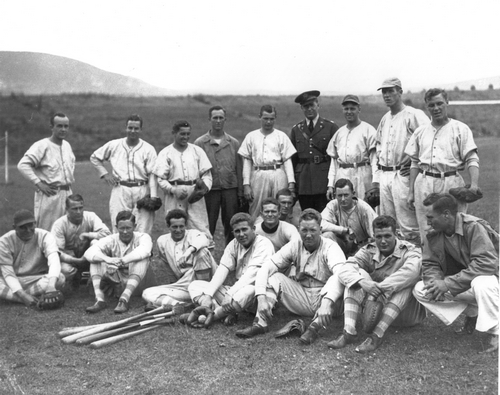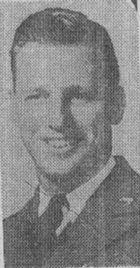George Zwilling
| Date and Place of Birth: | 1919 Cincinnati, OH |
| Date and Place of Death: | March 31, 1943 Fondouk, Tunisia, North Africa |
| Baseball Experience: | Minor League |
| Position: | Shortstop |
| Rank: | Private First Class |
| Military Unit: | 135th Infantry Regiment, 34th Infantry Division US Army |
| Area Served: | Mediterranean Theater of Operations |
Like his father, George Zwilling was a well-known baseball player in Cincinnati. Like his father, he would fight for his country in a World War. But unlike his father, George Zwilling wouldn't come home.
George C. Zwilling was born in Cincinnati, Ohio, and attended St. Francis and Rothenberg schools. Like his father, Charles, George became a well-known semi-pro baseball player in the city, playing shortstop with the Schoenling Brewery and Rauh Shirt Company teams. In the fall of 1941, Zwilling was signed by the Cincinnati Reds and assigned to the Columbus Red Birds of the Class B South Atlantic League for the 1942 season. But on October 20, 1941, before he had the opportunity to pull on the Red Birds' uniform, Zwilling entered military service at the Fort Thomas Army Reception Center in Kentucky.
He took basic training at Camp Wolters, Texas, and in May 1942,
Private First Class Zwilling was on his way to Northern Ireland with the
135th Infantry Regiment, 34th "Red Bull" Infantry Division - the first
American servicemen to reach the European Theater. On April 25, 1942,
despite overcast and blustery conditions, Zwilling played in a ball game
between two battalions that attracted an inquisitive crowd of Irish
folk. Games continued to be played whenever the troops had respite from
their training routine, and on July 4, 1942 - to celebrate Independence
Day - the first officially recognized baseball game in Ireland since the
First World War, took place at Windsor Park, Belfast. Zwilling played
shortstop for the 34th Infantry Division Midwest Giants against the 1st
Armored Division Kentucky Wildcats. In front of an enthusiastic if
somewhat bewildered crowd of locals and dignitaries, Zwilling was 2 for
3 at the plate in the Midwest Giants' 3-2 win.
In November 1942, the 34th Infantry Division left Northern Ireland to
participate in Operation Torch - the Allied invasion of North Africa. It
was the Division's job to overcome the Vichy French forces at Algiers,
Algeria. On November 7, 1942, the division disembarked at Algiers and
met with sporadic resistance that led to the capture of Zwilling and
others, and they were held prisoner by the French. A British sailor,
Douglas Derbyshire, who had befriended Zwilling in Northern Ireland and was captured at the
same time, later wrote to the Cincinnatian's family to explain the
situation. "We were all very tired when we were captured," wrote
Derbyshire, "as we had been up all night under shell fire while
approaching the harbor of Algiers, and all day we were trying to clear
out the French soldiers." The British sailor added: "It was an honor to
be with your boys under shell-fire and machine-gun fire - they were
magnificent!"'
After a couple of days, they were released by the French and by February 1943 the 34th Infantry Division was in Tunisia advancing towards Rommel's Afrika Korps, who were in retreat from the British. Zwilling's last letter home said, "keep your fingers crossed," because he hoped to be home on furlough in a couple of months.2 Under the command of the British IX Corps, the division was assigned to break through the German defenses. On March 27, 1943, the division prepared for its first major attack of the war at Fondouk Gap. The German forces were well prepared with defensive positions burrowed in the solid rock. The approaches were bare and flat, with barbed wire and minefields on the bottom slopes of the hills. The operation was a head-on assault in the face of the enemy and casualties were heavy. Private First Class Zwilling was killed on March 31, 1943. The following day the division was ordered to abandon its efforts and to withdraw to a temporary line until further plans could be made.
On May 1, 1943, a requiem high mass was held for George Zwilling at St. Francis Seraph Church, near his home in Cincinnati, and attended by soldiers from the Fort Thomas Army Reception Center. He was buried at the North Africa American Cemetery in Carthage, Tunisia.
|
Team |
League |
Class |
G |
AB |
R |
H |
2B |
3B |
HR |
RBI |
AVG |
|
| 1941 | Columbus | South Atlantic | B | Signed but did not play | ||||||||

The 34th Infantry Division Midwest Giants,
Northern Ireland, July 1942
(George Zwilling is back row, third from right)
Notes
1. Cincinnati Times-Star, January 13, 1943.
2. Cincinnati Post, April 16, 1943.
Date Added June 3, 2012 Updated June 13, 2014
Baseball's Greatest Sacrifice is associated with Baseball Almanac
Baseball's Greatest Sacrifice is proud to be sponsored by


